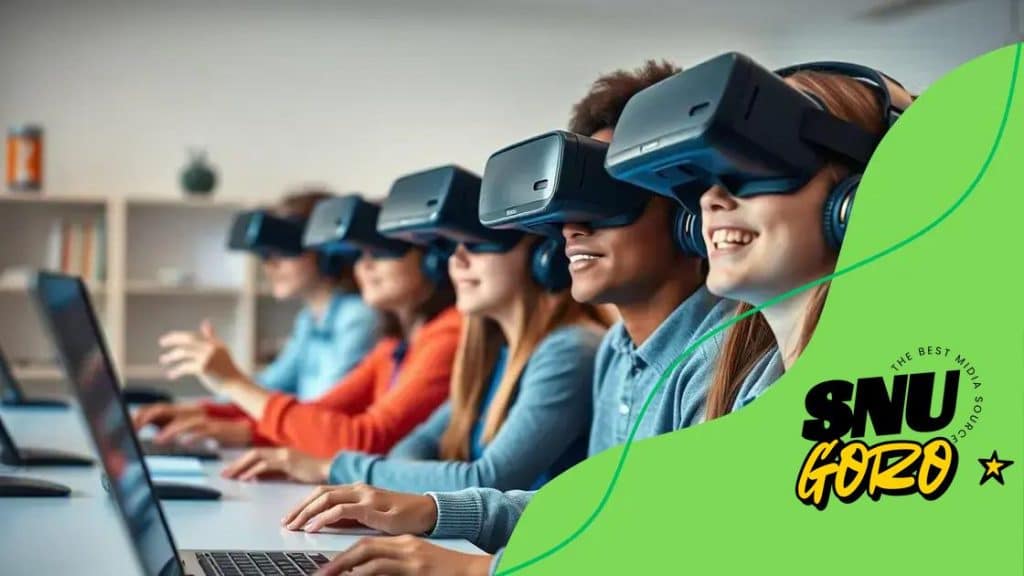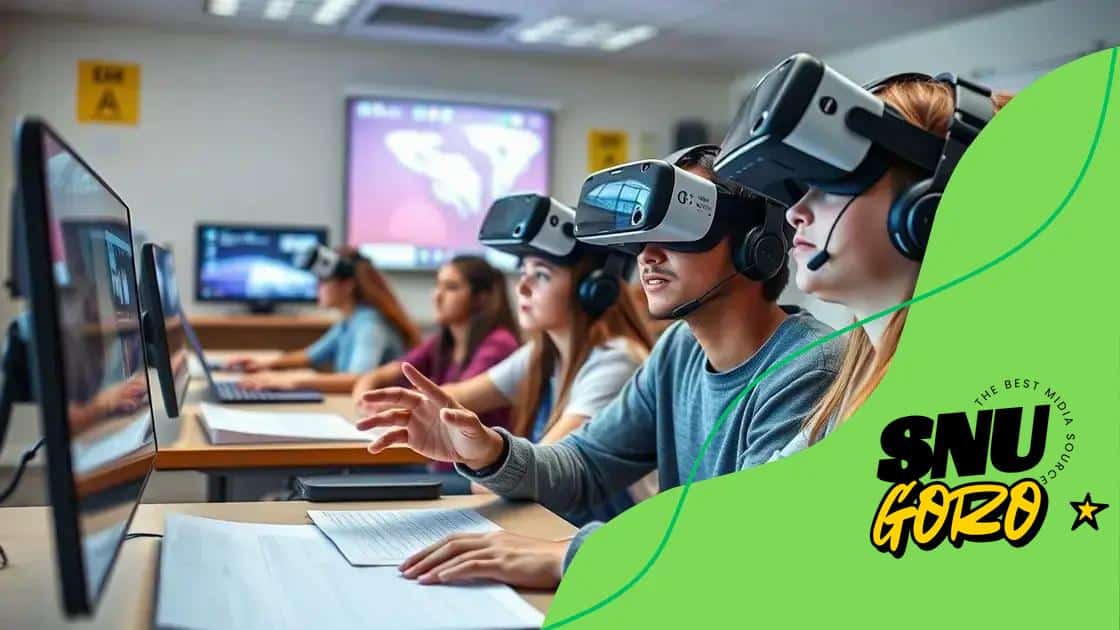Virtual reality labs in STEM education: transforming learning

Virtual reality labs in STEM education enhance student engagement and understanding by providing immersive, hands-on experiences that replicate real-world scenarios and allow practical application of complex concepts.
Virtual reality labs in STEM education offer an innovative twist to traditional learning methods. Imagine stepping inside a molecular structure or exploring the inner workings of a robot from your classroom. It’s not just fun; it’s the future of education.
What are virtual reality labs?
Virtual reality labs are innovative spaces designed to enhance the learning experience by allowing students to immerse themselves in virtual environments. These labs blend technology with education, providing a unique platform where learners can explore complex scientific concepts, conduct experiments, and engage in interactive simulations.
In a virtual reality lab, students wear VR headsets that transport them into 3D worlds. Imagine walking through the human body or manipulating physical forces without leaving your classroom. This level of engagement helps students understand challenging STEM subjects in a way that textbooks cannot.
Key Features of Virtual Reality Labs
Some notable aspects of VR labs include:
- Immersive learning experiences that captivate students’ attention.
- Hands-on experiments in a safe, controlled environment.
- Access to simulations of real-world scenarios that might be difficult to recreate in a traditional classroom.
These features make virtual reality labs extremely effective for teaching STEM subjects. For instance, when students can visually and practically see the effects of chemical reactions or physics principles, they are more likely to remember these lessons. Such labs allow for innovative approaches that cater to various learning styles.
Benefits of virtual reality in STEM education
The benefits of virtual reality in STEM education are numerous and impactful. By integrating VR technology into the curriculum, educators can offer students unique experiences that traditional methods cannot provide. This innovative approach captivates students while making complex subjects easier to understand.
Enhanced Engagement
One of the major advantages of using virtual reality is the enhanced engagement it brings to the classroom. When students wear VR headsets, they are transported into a new world where they can actively participate in lessons rather than just listening. This active participation sparks curiosity and motivates students to explore further.
Real-World Simulations
Another significant benefit is the ability to create real-world simulations. In a virtual reality lab, students can safely experiment with scenarios they might not encounter in real life. For instance, they can conduct chemical experiments or explore space environments without the risks associated with physical experiments.
- Students understand complex concepts more clearly.
- Hands-on practice fosters deeper learning.
- Encourages collaboration and teamwork among students.
Additionally, VR promotes collaboration among learners. When working together in virtual environments, students can communicate and solve problems as a team. This collaborative approach mimics real-world working environments and prepares them for future careers.
Furthermore, VR caters to diverse learning styles. Visual learners benefit from the immersive environments, while kinesthetic learners gain from hands-on simulations. This technology can reach students who might struggle with traditional teaching methods and help them succeed.
How VR enhances student engagement

Virtual reality (VR) significantly enhances student engagement in education. When students enter a virtual reality environment, they experience a level of interaction that traditional classrooms often lack. This hands-on approach captures students’ attention and invites them to explore concepts actively.
Interactive Learning Experience
In a VR setting, learning becomes a vibrant adventure. Instead of passively listening to a lecture, students can manipulate objects, explore different scenarios, and take part in immersive simulations. This interactive learning experience fosters curiosity and encourages deeper understanding of the subject matter.
Motivation Through Immersion
Additionally, the immersive quality of VR technology is unmatched. When students are fully immersed in a virtual world, they become more motivated to engage with the content. VR transports them to new environments, making lessons more exciting and relatable. This can be especially beneficial for students who might find traditional learning methods too dull.
- It creates memorable learning experiences.
- Encourages active participation and curiosity.
- Helps students feel like they are part of the subject.
Furthermore, VR also caters to diverse learning styles. Visual learners enjoy the graphics, while tactile learners benefit from physically interacting with the environment. This versatility ensures that all students can find a way to connect with the material, enhancing their overall educational experience.
Ultimately, the unique features of VR allow educators to create more engaging and effective learning environments. By integrating this technology, students not only learn better but also develop a genuine interest in STEM subjects, which can lead to higher achievement and career aspirations.
Real-world applications of VR in education
Real-world applications of virtual reality (VR) in education are transforming the way students prepare for their future careers. This technology is not just about creating fun experiences; it’s about providing practical skills and knowledge that are essential in today’s job market. By applying VR in various fields, students can gain hands-on experience in a safe and controlled environment.
Healthcare Training
In the healthcare industry, VR is being used extensively for training purposes. Medical students can practice surgeries and procedures without the risk of harming real patients. They can explore human anatomy in 3D and perform virtual operations, gradually building their skills and confidence.
- VR allows for repeated practice without real-world consequences.
- Students can learn complex procedures at their own pace.
- It enhances their understanding of anatomy and surgical techniques.
This hands-on training ensures that future healthcare professionals are well-prepared when they start working with actual patients.
Engineering Simulations
Another exciting application of VR is in engineering education. Students can engage in simulations that replicate real-world challenges. For example, they can design and test structures under various conditions, such as weather or seismic activity, which is significantly easier with VR technology.
Such applications allow students to:
- Conduct experiments without the need for physical materials.
- Visualize and analyze data in a more interactive way.
- Enhance teamwork skills through collaborative projects.
Furthermore, VR is being utilized in fields such as architecture, where students can walk through their designs before they are built. This not only helps them refine their ideas but also gives them insights into how their creations will function in real life. The ability to simulate real-world scenarios prepares students for their professional lives, making them more competitive in the job market.
Challenges of integrating VR in classrooms
Integrating virtual reality (VR) in classrooms presents several challenges that educators must navigate. While the benefits are clear, there are obstacles that can make this integration complex and sometimes discouraging.
Cost of Technology
One of the primary challenges is the cost associated with VR technology. Schools may struggle to find funds to purchase headsets and other necessary equipment, as well as maintain them. This financial burden can limit access for many students, preventing the technology from being utilized effectively.
Technical Difficulties
Another challenge is the technical difficulties that can arise when implementing VR. Many teachers may not have adequate training to use this technology proficiently. Additionally, issues such as software compatibility and hardware malfunctions can disrupt the learning process.
- Teachers need training and support to effectively use VR.
- Technical issues can create frustration for both students and educators.
- School IT resources may be stretched thin trying to solve these problems.
Moreover, VR can require significant setup time, diverting attention from lesson plans. When educators face these hurdles, they may hesitate to fully integrate VR into their teaching strategies.
Student Distraction
Furthermore, while VR can be engaging, it can also lead to distractions. Some students might be more interested in the VR experience than the educational content. Teachers must find ways to ensure that students remain focused on learning objectives while experiencing the immersive technology.
In addition to finding a balance, educators need to create structured assignments and assessments that align with VR experiences. This way, students can take full advantage of VR’s potential while also achieving educational goals.
In conclusion, integrating virtual reality in education has the potential to revolutionize classrooms. While there are challenges like costs, technical difficulties, and student distractions, the benefits far outweigh these obstacles. By embracing VR, educators can enhance student engagement, provide real-world applications, and create immersive learning experiences. As schools work to overcome these hurdles, the future of learning can become brighter and more interactive.
FAQ – Frequently Asked Questions about Virtual Reality in Education
What are the main benefits of using virtual reality in classrooms?
Virtual reality enhances engagement, provides real-world applications, and creates immersive learning experiences that aid understanding.
What challenges do schools face when integrating VR technology?
Schools often struggle with costs, technical difficulties, and the need for adequate teacher training to effectively use VR.
How does VR help students in STEM education?
VR allows students to visualize complex concepts, engage in hands-on simulations, and practice real-world skills in a safe environment.
Are there any risks associated with VR use in classrooms?
Yes, potential risks include student distractions and the need for proper supervision to ensure that VR experiences align with learning objectives.





